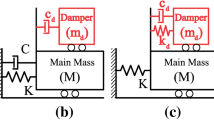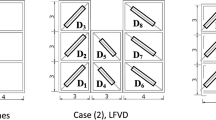Abstract
The performance-based passive control analysis of the Maxwell dampers between one 10-story and one 6-story adjacent RC frames is conducted in this work. Not only the optimal parameters but also the optimal arrangements of the Maxwell dampers are proposed based on the optimal target of making the total exceeding probability of the adjacent structures to be minimal. The applicability of the analytical expressions of the Maxwell damper damping parameters under different seismic performance targets are firstly examined and then the preferable damping parameters of the Maxwell dampers are proposed through the extensive parametric studies. Furthermore, the optimal arranging positions and optimal arranging numbers of the Maxwell dampers between the adjacent buildings are derived based on a large number of seismic fragility analyses, as well. The general arranging laws of the Maxwell dampers between the adjacent buildings are generated based on the discussion of the theoretical method through the simplified plane model. The optimal parameters and optimal arrangement of the Maxwell dampers presented make both the adjacent structures have preferable controlled effects under each seismic performance target which can satisfy the requirements of multi-performance seismic resistance of the modern seismic codes.
Similar content being viewed by others
References
ZHU Hong-ping, IEMURA H. A study of response control on the passive coupling element between two parallel structures [J]. International Journal of Structural Engineering and Mechanics, 2000, 9(4): 383–396.
ZHU Hong-ping, YANG Zi-jian, TANG Jia-xiang. Control of the seismic response of two adjacent structures using a damped link [J]. Journal of Vibration Engineering, 2003, 16(1): 57–61. (in Chinese)
ZHU Hong-ping, YU Yong-min, and TANG Jia-xiang. Optimal passive control of primary-auxiliary structures under earthquake excitation [J]. Chinese Journal of Applied Mechanics, 2000, 17(2): 63–69. (in Chinese)
ZHU Hong-ping, IEMURA H. A study on interaction control for seismic response of parallel structures [J]. Computers and Structures, 2001, 79(2): 231–242.
ZHU Hong-ping, LIANG Lu. Comparative study of passive optimum control for reducing seismic responses of adjacent structures [J]. Engineering Mechanics, 2005, 22(S): 183–187. (in Chinese)
ZHU Hong-ping, XU You-lin. Optimum parameters of Maxwell model-defined dampers used to link adjacent structures [J]. Journal of Sound and Vibration, 2005, 279(1, 2): 253–274.
ZHU Hong-ping, WENG Shun, CHEN Xiao-qiang. Optimum parameters of Maxwell-defined dampers for reducing the seismic responses of adjacent structures under earthquake [J]. Chinese Journal of Applied Mechanics, 2006, 23(2): 296–300. (in Chinese)
XU You-lin, ZHANG W S. Closed-form solution for seismic response of adjacent buildings with LQG controllers [J]. Earthquake Engineering and Structural Dynamics, 2002, 31(2): 235–259.
BHASKARARAO A V, JANGID R S. Seismic analysis of structures connected with friction dampers [J]. Engineering Structures, 2006, 28(5): 690–703.
BHASKARARAO A V, JANGID R S. Seismic response of adjacent buildings connected with friction dampers [J]. Bulletin of Earthquake Engineering, 2006, 4(1): 43–64.
BHASKARARAO A V, JANGID R S. Optimum viscous damper for connecting adjacent SDOF structures for harmonic and stationary white noise random excitations [J]. Earthquake Engineering and Structural Dynamics, 2007, 36(4): 563–571.
BASILI M, ANGELIS M D. A reduced order model for optimal design of 2-mdof adjacent structures connected by hysteretic dampers [J]. Journal of Sound and Vibration, 2007, 306(1, 2): 297–317.
BASILI M, ANGELIS M D. Optimal passive control of adjacent structures interconnected with nonlinear hysteretic devices [J]. Journal of Sound and Vibration, 2007, 301(1, 2): 106–125.
OK S Y, SONG J, PARK K S. Optimal design of hysteretic dampers connecting adjacent structures using multi-objective genetic algorithm and stochastic linearization method [J]. Engineering Structures, 2008, 30(5): 1240–1249.
RICHARDSON A, WALSH K K, ABDULLAH M M. Closed-form equations for coupling linear structures using stiffness and damping elements [J]. Structural Control and Health Monitoring, 2013, 20: 259–281.
PATEL C C, JANGID R S. Dynamic response of identical adjacent structures connected by viscous damper [J]. Structural Control and Health Monitoring, 2014, 21: 205–224.
TUBALDI E. Dynamic behavior of adjacent buildings connected by linear viscous/viscoelastic dampers [J]. Structural Control and Health Monitoring, 2015, 22: 1086–1102.
EUROCODE 8. Design of structures for earthquake resistance; Part 1: General rules, seismic actions and rules for buildings, EN 1998–1 [S]. Brussels: European Committee for Standardization, 2005.
GB50011–2010. Code for seismic design of buildings [S]. Ministry of Housing and Urban-Rural Development. Beijing, China, 2010. (in Chinese)
GB50009–2012. Load code for the design of building structures [S]. Ministry of Housing and Urban-Rural Development. Beijing, China, 2010. (in Chinese)
GB50010–2010. Code for design of concrete structures [S]. Ministry of Housing and Urban-Rural Development. Beijing, China, 2010. (in Chinese)
OpenSees, Open system for earthquake engineering simulation [EB/OL]. [2016–04–01]. http://opensees.berkeley.edu.
Pacific Earthquake Engineering Research Center-PEER. Next Generation Attenuation Database [EB/OL]. [2016–04–01]. http://peer. berkeley. edu/peer_ground_motion_database/24/10/2012.
FEMA 356. Prestandard and commentary for seismic rehabilitation of buildings [S]. ASCE for Federal Emergency Management Agency, Washington, D.C., USA, 2000.
Author information
Authors and Affiliations
Corresponding author
Additional information
Foundation item: Projects(51408443, 51178203) supported by the National Natural Science Foundation of China; Project (K201511) supported by the Science Foundation of Wuhan Institute of Technology, China
Rights and permissions
About this article
Cite this article
Wu, Qy., Dai, Jz. & Zhu, Hp. Performance-based passive control analysis of adjacent structures: Optimization of Maxwell dampers. J. Cent. South Univ. 24, 2180–2197 (2017). https://doi.org/10.1007/s11771-017-3627-1
Received:
Accepted:
Published:
Issue Date:
DOI: https://doi.org/10.1007/s11771-017-3627-1




